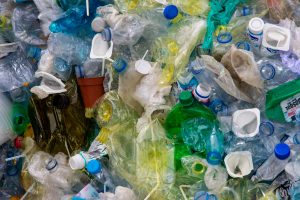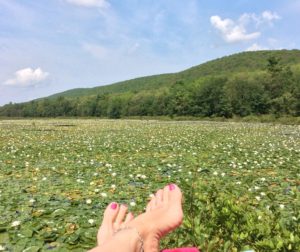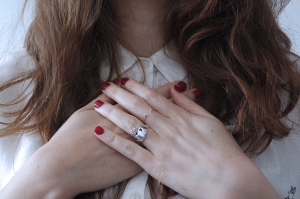
Talking Trash about Trash
Instagram disturbs me. That is, when it is not amazing me. My mind has been blown again and again by the most creative works of art on the planet.


Instagram disturbs me.
That is, when it is not amazing me. My mind has been blown again and again by the most creative works of art on the planet – the never ending array of sea creatures who quietly inhabit the oceans on our beautiful planet.
Soon after I got on Instagram, I dumped most of the inspirational folks I followed so that I could make room for the creatures who were swimming, crawling, and decorating our oceans.
So I could learn from the humans who were documenting their existence, educating me on their features/functions, and creatively improving the health of the oceans. I enjoyed my favorite art museum appearing underwater all over the world as Jason deCaires Taylor anchors his sculptures on the ocean floor to create artificial reefs. As I became more enamored with my underwater friends, my sense of wonder turned into a sense of horror.
These precious creatures are our neighbors and we are killing them slowly.
I knew some of this. Most people have some idea of the amount of plastic in the oceans. I was doing some minimal effort toward decreasing my contribution to the plastic problem. By minimal, I mean minimal. I was very good at recycling, used my own bags sometimes, picked up trash wherever I went, donated consciously, and ordered lots of 4Ocean bracelets. However, as groups like @4Ocean, @recycleseas, @ocean.diary, and others shared their images and I began to research the issue, I realized there is a frightening amount of plastic and trash in the ocean. And it is getting worse.
I also recognized that my minimal effort was the result of my comfortable lifestyle and (up until now) innocent ignorance.
I had been schooled in the belief that if I recycled a plastic bag/bottle or used a reusable water bottle or grocery sack, I was somehow part of the solution. I have a distant memory of my youth with people throwing McDonald’s bags out of car windows and food wrappers on the ground as they walked. Luckily those days are gone yet they created in me a habit of picking up trash especially in natural environments so it does not end in streams, rivers, and lakes (all headed to the ocean). After witnessing images of trucks dumping trash into rivers, surfers paddling through oceans of floating plastic, analysis of the micro plastic particles in fish, and a baby turtle caught in a plastic cap (having crawled through a crack), I realized something else entirely.

I took a look at our family’s giving plan and found that we already were contributing strongly to organizations focused on cleaning the oceans, environment, and protecting marine/animal habits. We agreed to increase our environmental volunteerism and talk more about the issue with those interested. We radically decreased our use of single-use plastic and adopted an ongoing commitment to taking the “next step” especially as we live in this modern, convenient world of “plastic around everything we purchase.” We have a long way to go, a lot more to learn, and a lifetime to contribute. And we are committed to changing our own behavior.
I was haunted by that video of the truck dumping trash into the river.
So I researched and learned how 10 rivers (8 are in Asia) are responsible for 88 – 95% of the ocean plastic due to a number of factors. These include lack of waste management systems, flimsy laws, an influx of plastic products, absence of policy, and a lack of education about the impact on our ecosystem. Not to mention an emerging market for plastic packaging as income increases allowing more purchasing. These products are typically in mini plastic pouches/bottles which are affordable, thus creating a wealth of plastic refuse.
I learned about “garbage gyres” which are vortexes of trash which cover miles of ocean.
Even more distressing was the fact this visible or floating trash represents only 5% of plastic pollution while 95% percent is submerged. 95%. Cue more distressing Instagram videos of sea horses eating plastic and (poignant) rescues of sea creatures being cut free from plastic lines. There are lots more facts, but you know how to Google and if you are interested, I hope you will.
After learning about the problem, I wondered what genius power of humanity was working on creative solutions.
I checked into one of my favorite feel good organizations: 4Ocean. Started by surfers who were dismayed by the plastic strewn over the Bali beaches and in the oceans, they began to pay fisherman (who could not fish due to polluted waters) to “fish” for plastic. I wear and gift my 4Ocean recycled bracelets (representing the removal of a pound of plastic) to remind myself and others of the benefit of changing our ways. Yet, I know they are dealing with the aftermath of a problem that must be addressed at its source.
I was thrilled when 4Ocean created a post on Haiti and hired locals to clear the trash.
I’ve witness first hand what Haiti looks like as there is no centralized trash collection, waste management process, or government funds/policy to support this small island with lots of people. The streets are lined with trash, often burning, as people in the overcrowded cities and countryside alike are left to dispose of their own trash. Good people. Human people. Who just happen to live in a place that has no sanitation/waste management system. I checked out the Instagram photos of a Haitian beach cleanup crew – saddened and gladdened by the photos. And for some inexplicable reason today, I decided to read the comments.
Lots of people were talking trash about trash … and the awful people who created it.
I won’t reprint those comments here. You can imagine the mix. Lots of saddened people. Lots of compliments for the wonderful 4Ocean people. And lots of awful comments about the disgusting humans who are wrecking our planet and who should know better. It was sobering. I realized that Instagram doesn’t offer a “mirror” option. It doesn’t ring a bell when our own innocent ignorance is revealed with the ease of typing our impulsive response.
Social media doesn’t offer a teachable moment where we might see ourself in those we judge so harshly.
It is easy to be angered, saddened, and judgmental when you see the horrors of these photos and videos. I’ve had all of those reactions. And if you haven’t lived in a place where there is no sanitation nor waste management system, let alone laws to govern safe behavior, then you really can’t walk in their shoes. Or spend the day as an 8 year old in Manilla waist high in a dirty river (of trash) scouring for plastic to sell so you can feed your family. I realized at the end of the day, I must educate myself more fully, significantly (not comfortably) change my behavior, and participate with others who would likely welcome a chance to go beyond the bare minimum.
I’m inspired enough to be uncomfortable because I love those sea creatures and the interdependent way we all inhabit this one world.
There are lots of avenues to learn more. Here is just one article pointing toward the problem of plastic pollution and those who are focused on finding the solution. Kudos to them. I dove into those websites to explore the proactive and responsive strategies as both are needed. I was grateful to see organizations involving young people as they will inherit these (plastic) oceans.
I’ll continue to use Instagram as a mechanism to disturb and delight me. (Although I’ll skip the comments from now on).
Whatever it takes to keep my focus on taking small steps to clean up the world around me – my home, my property, my neighborhood, my behavior, my world. From there, I’ll join others who are doing the same.
Peace be with you and with all. No exceptions.


Reforesting heads below Sea Level. The loss of ocean sea grass and plants due to pollution is dangerous for the planet. Until recently, replanting the ocean floor seemed insurmountable. Australian marine ecologists have succeeded in replanting two vital species with the help of local citizens. Volunteers collect sea grass shoots that wash up on shore so scientists are free to replant. Providing a “nursery habitat” to juvenile seahorses, crabs, and fish. Scientists worldwide are interested in adopting this model.



Learn the one essential skill that allows you to face any challenge with confidence, sturdiness, and inner calm.
More than a technique. It’s a game changer.


Instagram disturbs me. That is, when it is not amazing me. My mind has been blown again and again by the most creative works of art on the planet.


“I had a near death experience in yoga today.” This was the text I sent my daughter after my first experience in the Heated Flow Yoga class at my new gym.


I’ve awakened the desire to go hiking and spend more time exploring the trails. My husband downloaded a hiking app and we chose our 5 mile hike.


Summers are my happy time being a warm weather creature. The comfort of warmer weather, longer days, and slower pace are soothing to my soul.


I brought dessert to the deck where my family was gathered under the night sky in the mountains. Something prodded me to check my email.


Sunday was a brilliant day as I found myself immersed in “Light Bathing.” This wasn’t my plan nor did that term pop into my mind until I was deeply in.

We use cookies to ensure that we give you the best experience on our website.